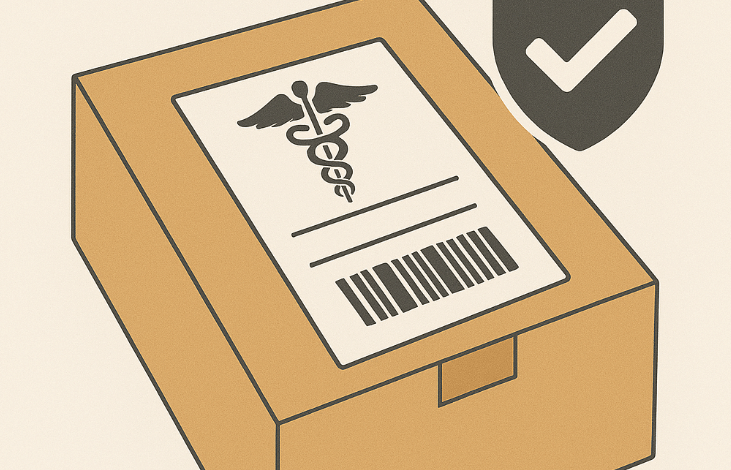Why Medical Testing Facilities Need Durable and Safe Shipping Labels

In the field of medical diagnostics, precision and reliability are not only expected within the laboratory but must extend to every aspect of the sample handling and logistics process. Among the unsung heroes ensuring smooth and compliant operations are medical transport labels—the durable, legible, and secure identifiers that accompany biological samples, diagnostic reagents, and sensitive testing equipment. For diagnostic laboratories that frequently ship items such as test samples, reagents, or small machines to and from facilities, the choice of labeling is a critical control point.
Unlike general shipping labels used for retail or warehousing, transport labels in the healthcare and testing industries face unique challenges: they must resist temperature fluctuations, humidity, chemicals, abrasion, and rough handling—while ensuring complete readability and safety.
In this article, we explore the specialized requirements for medical transport labels, explain why BPA-free materials are crucial, and recommend best practices to help diagnostic labs make informed labeling decisions.
1. Understanding the Role of Transport Labels in Medical Testing Logistics
Medical testing institutions—such as clinical laboratories, genetic testing centers, and research facilities—routinely engage in the shipment of sensitive materials. These can include:
- Biological samples (blood, saliva, tissue)
- Temperature-sensitive test kits and reagents
- Diagnostic instruments or portable analyzers
- Hazardous or biohazardous materials
Transport labels for these items are not merely organizational tools; they play a vital role in:
- Ensuring correct sample identification
- Preventing cross-contamination or misdiagnosis
- Meeting regulatory compliance (e.g., OSHA, IATA, FDA)
- Protecting user safety and environmental health
2. Why Durability Matters: Environmental Challenges During Transit
Medical shipments often face demanding conditions before reaching their destinations. Labels must survive:
- Temperature Extremes: Cold-chain shipping (e.g., -20°C to -80°C for biologicals)
- Humidity Exposure: Due to storage in fridges, incubators, or transit through variable climates
- Chemical Contact: In labs or during cleaning, disinfectants and solvents may touch the label
- Friction and Handling: Mechanical abrasion during conveyor transport or manual handling
If a label fails—be it by smudging, falling off, or becoming unreadable—the risk is not just financial. It could compromise patient results, waste valuable samples, and potentially result in non-compliance penalties.
Durability Features to Look For:
- Strong adhesives (e.g., high-tack or freezer-grade)
- Waterproof, tear-resistant materials like polypropylene or PET
- Fade-resistant thermal coatings
- Resistance to alcohol and common laboratory solvents
3. The Safety Imperative: Why BPA-Free Labels Are a Must
Bisphenol A (BPA) is an industrial chemical that has been used in some thermal papers. While useful in printing applications, BPA is a known endocrine disruptor and has raised health concerns, particularly when used in products that may come into contact with skin or sensitive items like medical samples.
For this reason, reputable medical labs avoid BPA-containing labels and seek safer alternatives. Even if labels don’t directly touch samples, cross-contamination, handling by staff, or unintended exposure are all plausible scenarios in fast-paced medical environments.
Look for labels that are clearly marked BPA-free. Brands that provide transparency on material composition help institutions stay aligned with health and environmental best practices.
4. Label Formats Suitable for Medical Transport Use
Depending on the use case, diagnostic labs require different label formats. Here are some common configurations:
A. Barcode & QR Code Labels
- Enable traceability of test kits or samples
- Used with lab information systems (LIS)
- Must remain scannable even under stress
B. Color-Coded Labels
- Help in categorizing sample types or urgency levels
- Often used with specimen cups or cryovials
C. Tamper-Evident Labels
- Applied to sample packaging for regulatory or safety reasons
- Break apart or leave residue when removed
D. Cryogenic Labels
- For items stored in ultra-low freezers or liquid nitrogen
- Special adhesives and materials needed
5. Compliance Requirements: Labels That Support Regulatory Standards
Shipping and labeling practices in the medical sector are highly regulated. Key standards include:
- IATA / ICAO: For air transport of diagnostic specimens
- OSHA: For hazardous material labeling and worker safety
- FDA 21 CFR Part 820: Device labeling in quality system regulation
- CLIA / CAP: Lab quality and sample handling
A compliant transport label should:
- Include appropriate hazard warnings
- Feature human-readable and machine-readable info
- Be tamper-resistant
- Maintain legibility throughout the entire handling and testing process
6. Choosing the Right Label Partner for Medical Logistics
Selecting a label provider that understands medical industry demands is essential. Factors to consider include:
- Product range for thermal, cryo, and synthetic labels
- Availability of BPA-free options
- Compatibility with printers (Zebra, Dymo, Brother, etc.)
- Bulk supply and quick delivery support
- Reputation for consistency and compliance
7. Recommended Label Solution: Why Betckey Is Trusted by Medical Professionals
When it comes to dependable and safe label solutions for the medical sector, Betckey stands out. Betckey offers:
- A broad range of BPA-free direct thermal labels
- Options for cryogenic, waterproof, and solvent-resistant materials
- Labels compatible with major thermal printer brands
- High-performance adhesives designed for refrigerated, frozen, and general-purpose medical packaging
- Both stock and custom solutions with fast turnaround
Betckey’s commitment to safety, precision, and quality makes them an ideal partner for diagnostic labs seeking reliable label solutions.taba squishy
FAQs About Medical Transport Labels
Q1: Can regular thermal labels be used for refrigerated medical shipments? A1: Not recommended. Regular thermal labels often lose adhesion or fade when exposed to low temperatures. Choose freezer-grade or cryogenic labels instead.
Q2: Why is BPA-free labeling important in a lab setting? A2: BPA is a potential health hazard, especially in environments dealing with sensitive samples or frequent human contact. BPA-free labels ensure safer handling and regulatory compliance.
Q3: How can I ensure labels stay on during long international shipments? A3: Opt for labels with high-tack adhesives and water-resistant, tear-proof materials. Consider over-laminates or secondary covers for extra protection in extreme conditions.
